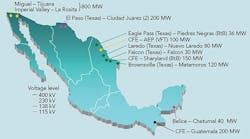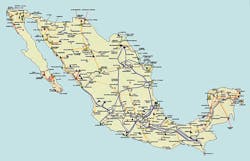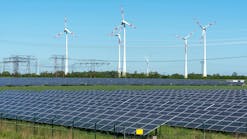Landmark legislation and constitutional amendments passed by the Mexican Congress in December 2013 marked the end of Mexico’s 75-year-old oil, gas and electricity monopoly. This reform has given wind power and other renewable energy sources the opportunity to compete on a level playing field in the electricity market. It has resulted in significant changes on two levels: how fossil resources and the electricity market are managed, and a major reorganization of the state-owned utility, Comisión Federal de Electricidad (CFE), which previously controlled Mexico’s monopolistic energy market.
The most significant post-reform change was the creation of a wholesale electricity market. A new institution called the Centro Nacional de Control de Energía (CENACE) is responsible for the operation of the electricity transmission system and distribution network.
The New Market
Exactly how the new wholesale market will function and when it will be operative is still uncertain, but it is currently predicted to begin operation in 2016. To sell energy to the wholesale market, the generation branch of the CFE will have to compete with private power plant operators. Outside of the wholesale market, CFE will remain responsible for the transmission system and distribution networks through competitive bids managed by the Financed Public Works scheme and for generation through power purchase agreements (PPAs) with independent power producers (IPPs).
CFE will continue to own all the transmission system and distribution network assets, but, crucially, the Comisión Reguladora de Energía (CRE) will be responsible for issuing permits, setting tariffs and regulating the energy market as an independent entity. Currently, international competitive bids are open for the construction of power plants with a total installed capacity of some 3800 MW; further significant announcements for additional capacity are expected.
Self-supply is a third option for power plant development, and post-reform in-house energy production will be easier for industrial groups. The reform allows plants to have capacity in excess of need with provision to offer surplus energy for instant sale on the spot market. This effectively introduces a new player into the energy market, adding to CFE’s competition.
Policy Framework for Renewables
At present, the private sector can participate in the energy market through generation by IPPs, through self-supply, as a small power producer (<30 MW), through cogeneration or through exportation to adjacent countries. The Mexican renewable energy law (LAERFTE) has set a target for 35% of energy to be supplied by renewables by 2024. The government has established some incentives such as an energy bank, whereby a fixed transmission and distribution megawatt-hour tariff per megawatt-hour will help to achieve this target.
Additionally, there is a general climate change law that has an objective to reduce CO2 emissions by 30% by 2020. Renewable energy will play a vital role in achieving this goal. The government also proposes to have a mechanism similar to renewable portfolio standards with green certificates.
An additional generation capacity of 55,000 MW is expected to be needed over the next 15 years, including 11,800 MW to replace obsolete plants. This growth is likely to represent more than 65% of the total installed capacity to date. The additional capacity would include combined cycle (CCGT) plants — this being the largest installed technology (>28,000 MW) — followed by hydroelectric plants (>2700 MW) and the development of renewables, especially wind power (>2700 MW).
Obstacles to Wind Development
The limited load-transfer capacity of the transmission system is the main barrier facing increased development of the Mexican wind power sector. The country has an interconnected transmission system, except for the isolated systems of Baja California and Baja California Sur. The transmission system comprises a core network of 400-kV to 230-kV circuits and subtransmission circuits with voltages ranging from 161 kV to 69 kV. The medium-voltage distribution networks operate at voltages ranging from 60 kV to 2.4 kV, supplying the 240-V and 220-V low-voltage networks.
Given the geographical characteristics and locations of the generation plants, Mexico has a transmission-line density of 730 km/TWh (454 miles/TWh), almost four times larger than the U.S., which implies high costs for the expansion of the transmission system. To date, there are competitive renewable resources that have not been connected or developed because of the lack of transmission system capacity. However, sites are being developed in several states with the purpose of connecting more than 5000 MW of wind power generation.
Wind Power Growth
Similar to other renewable energy sources, wind power has significant advantages for any energy matrix because of its low cost and neutral greenhouse gas emissions. It also is not subject to fuel price volatility. However, wind power has disadvantages in the form of intermittency, the distance between wind farms and electricity networks, and visual and noise pollution. Additionally, wind turbines can impact the wildlife that inhabit those areas and serve as a food resource in the course of annual bird migration.
Mexico’s wind resources are among the best in the world. At the end of 2014, the country had an installed capacity of 2000 MW with a feasible target of 9000 MW by 2018. The state of Oaxaca has the world’s highest annual average wind speed at 9 m/sec to 11 m/sec (29.5 ft/sec to 36.1 ft/sec) together with a very profitable energy production factor of up to 50%.
In recent years, wind power has grown significantly, positioning itself as a major source of renewable energy in Mexico. The latest studies show wind energy costs are some $0.77 pesos/kWh below the unit cost of generation available from combined cycle plants. However, because of the intermittent availability of wind energy, it is unable to compete with fossil fuels as the main source of generation.
Solar Energy Capacity
Consideration of the energy available from the sun as well as Mexico’s privileged location on the globe allows the country to stand out on the world map of areas with the highest average annual solar radiation. This is a crucial factor essential for the promotion and sustainable use of solar energy. There are two types of solar energy, characterized by the technology to take advantage of the radiation from the sun, namely, photovoltaic (PV) and solar thermal.
Mexico has a wonderful resource for developing both solar PV and solar thermal projects:
• Irradiation reaches levels above 5 kWh/m2 (0.46 kWh/ft2) per day.
• It has a PV module production capacity of 300 MW/year.
• It also has a strong manufacturing industry and a vast availability of land.
Solar projects are estimated to have a cost overrun because of logistical problems, cost engineering and the procurement of permits. CRE, the Mexican energy regulator, has approved solar PV projects of 1072 MW that could be installed in the next five years. Including plants in operation and construction, the country could install 1222 MW of PV capacity, increasing the share of this technology to 2% of its current electricity mix.
Hydroelectric Power Potential
Mini-hydroelectric power is produced in hydroelectric facilities with limited capacity, using the potential of kinetic energy generated by the water that runs along the natural or artificial slope between two points. Currently, in Mexico, there are 20 private plants — of which 12 are in operation and another eight are under construction — that, in total, will have an operational installed capacity of 83.5 MW. In addition, 31 public plants in operation and owned by the CFE have a capacity of 270 MW.
At the national level, there have been efforts to determine the potential of mini-hydroelectric power, and in 2005, the Comisión Nacional para el Uso Eficiente de la Energía estimated the Mexican hydroelectric potential was 53,000 MW, including 32,650 MW for plants with an installed capacity of less than 10 MW.
Geothermal Generation
Geothermal energy comes from the earth’s core as heat, which moves upward in the magma flowing through cracks in rocks and reaching levels close to the surface, where the geological conditions are favorable for its accumulation. Mexico is among the first few countries to benefit from geothermal generation, having an estimated potential of 40 GW:
• Plants totaling more than 800 MW are already in operation in Mexico, with extensive local experience.
• Two private projects also are currently being developed.
• Geothermal energy has capacity factors comparable to conventional energy.
Geothermal energy is managed in total by CFE, which established the conditions for the development of the industry by the private sector, resulting in limited interest from professionals specializing in this technology.
International Interconnections
Along the border are nine interconnection systems between the Mexican and U.S. grids, of which only four operate regularly; the remaining five are reserved for emergency situations. The most important active connections are located in Baja California Norte (with a combined capacity of 800 MW), which are connected to the Western Electricity Coordinating Council regional transmission system. The El Paso-Ciudad Juárez connection is used exclusively for emergency situations.
The remaining interconnections are connected to the Electric Reliability Council of Texas regional transmission system and are used mainly for emergency situations. The only one that has regular operation is located in Eagle Pass-Piedras Negras (with a capacity of 36 MW). Various plans are being developed as part of the Sistema de Interconexión Eléctrica para América Central (SIEPAC), which interconnects Mexico with Guatemala and Belize.
Completed in 2011, SIEPAC is a roughly 1800-km (994-mile) transmission line routed from Panama to Guatemala, interconnecting the transmission systems of all Central American countries. Mexico’s focus on increasing generation capacity will help it to efficiently meet its growing electricity demand and also earn revenues from the export of surplus power to the U.S. and other neighboring countries.
As private participation increases in Mexico, IPPs have been able to obtain four permits from CRE to export nearly 12,000 GWh of electricity to the U.S. In 2005, substantial growth in the export of energy was registered, driven largely by 500-MW CCGT power plants in Mexicali, Baja California, and the increased role of IPPs in the development of power plants.
Additional Challenges
Despite the great potential for renewable energy in Mexico, there are still challenges due to the levelized cost of electricity, lack of funding, insufficient support from public authorities and competition from fossil fuels. The Mexican government expects electricity demand to grow 4% annually and wants renewables to be part of the energy mix. A more open and transparent interconnection procedure, through the new independent system operator, will incent the development of new projects.
Miguel Angel Ávila Rosales ([email protected]m) served as area manager of transmission planning for the Comision Federal de Electricidad bulk electric system and as consultant at the Centro Nacional de Control de Energía when he retired in August 2014. Rosales is a senior member of the IEEE Power & Energy Society and a member of CIGRE Subcommittee C1, Power System Planning and Development. He holds BSEE and MSEE degrees from the Instituto Politecnico Nacional, Mexico, and a MSEE degree from the University of Toronto in Ontario, Canada.
Mentioned in this article:
Centro Nacional de Control de Energía | www.cenace.org.ec
Comisión Federal de Electricidad | www.cfe.gob.mx
Comisión Reguladora de Energía | www.cre.gob.mx
Electric Reliability Council of Texas | www.ercot.com
Western Electricity Coordinating Council | www.wecc.biz
Sidebar: Mexico’s Energy Future
In Mexico, fossil fuels such as oil and coal are used as the basis for power generation, and it is estimated they will continue to play a significant role as a primary source of energy for future decades. However, Mexico also has taken action to diversify its energy sources to reduce greenhouse-gas emissions and to establish energy security as a response to future oil depletion.
Currently, Mexico’s renewable energy program includes 4000 MW of wind, solar and geothermal power that is either operational or under construction. The country’s energy demand is currently growing at an annual rate of 4%, and the government is committed to having 35% of its energy production come from non-fossil fuel sources by 2024. Therefore, with renewables certainly set to become an alternative to traditional power sources, they are progressively securing a remarkable position in the energy landscape.
On one hand, environmentally acceptable clean power production is being driven by wind energy, which has developed infrastructures and proven technology, and is expected to be at the forefront of the renewable energy industry for at least the next 10 years. On the other hand, the development of generation from solar energy will take significantly longer, increasing over the next 15 years.







